Taking care of pet fish is not much different than being responsible for a cat or dog. Fish, like any other land animal, can get sick. Your fish are susceptible to multiple nasty diseases. To keep them healthy and happy, you must always be attentive to the environment of your aquarium.
How to tell a fish is sick?
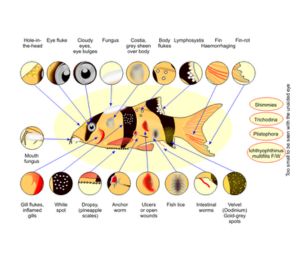
You might notice many physical and behavioral changes in your fish if it has fallen prey to disease. Some fish diseases lead to external spots or wounds, which you will be able to note easily. However, other ailments do not have such prominent signs. They might just affect the swimming habits of a fish, for instance, it may not be able to swim to the bottom or top of the tank. What’s alarming is that some fish might not show signs of sickness at all and just die out of the blue. When that happens, make sure you check the tank’s water quality and inspect other fish for any disease.
What’s making your fish sick?
The most common culprit for causing diseases in fish is poor water quality. Swimming in contaminated water can make your fish fall sick easily. There are three main parameters to check when it comes to water quality.
The first is the water temperature. Different fish like different temperatures of water, it’s important to know your fish’s preferred temperature range before introducing it to the tank. You might even have to make temperature adjustments daily to keep the water as cool or warm as your fish likes.
The second parameter that determines an aquarium’s water quality is ammonia. Ammonia is the natural waste product of fish, which can cause “brown blood disease” or methemoglobinemia in your fish if not removed from the tank system by water changes. Bacteria present in the water convert ammonia into nitrite and nitrate, which tends to bind with the hemoglobin in your fish’s blood and cause it to suffocate by taking the place of oxygen. Hence, it’s essential to remove ammonia from the tank on a regular basis.
Finally, the third important factor determining your fish’s health is the circulation of water in the aquarium. If the water is stagnant, it can lead to your fish using up all available oxygen and suffocating. Install a bubbler or air stone in your tank to keep up the circulation of water and prevent your fish from getting any of the following diseases.
Disclosure: This article contains affiliate links. When you follow a link to purchase the products, I sometime earn a commission, at no additional cost to you. Read my full disclosure here
Common Aquarium Fish Diseases
Here is a comprehensive guide to freshwater fish diseases and their cures that every proud fish owner should carefully peruse.
1. White Spots
Are there noticeable white spots on your fish? Don’t worry, it’s possible that the white spots on fish are not ick – which is an infection caused by fish parasites and can be fatal if left untreated. Water quality is one of the reasons for white spots to appear on fish. While it might not indicate a serious health risk, you should still test the water in your tank and ensure that it’s suitable for your fish.
In case dots composed of white granular material appear on your fish, that’s when you should promptly take action because that’s ick. To prevent the spread of the infection, isolate the affected fish from the rest of the aquarium.
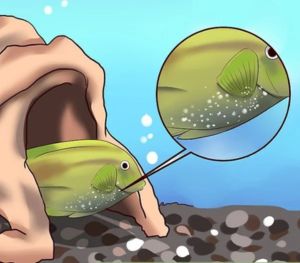
Treatment for White Spots
The first step to cure white spots on fish is to ensure that your aquarium has the correct water temperature. You should also change the water regularly to maintain ammonia levels in the tank.
A poor diet could also lead to white spots, so try to provide a balanced diet to your fish based on a variety of fresh and frozen foods.
Adding aquarium salts can help prevent white spots in fish by reducing their stress level and treating minor bacterial infections. However, if bacterial infection on fish gets serious, then have your veterinarian prescribe antibiotics to treat white spots. Make sure you follow the instructions carefully while administering fish medicine to ensure your pets’ safety.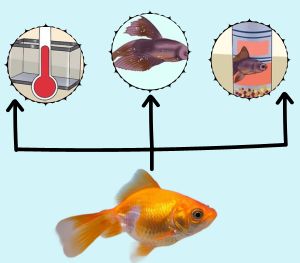
2. Dropsy
Caused by a bacterial infection, dropsy in fish leads to inflammation of the bodily tissues. Parts of a fish’s anatomy, such as eyes, gills and glands,if not the entire fish suffers from extreme swelling due to fluid buildup inside the body cavity. Loss of appetite, and pale and stringy feces are also some of the symptoms of dropsy.
The underlying cause of dropsy in fish is a compromised immune system that leaves them susceptible to bacterial infection. A fish’s immunity is lowered when it’s exposed to stress for an extended period of time. This stress can result from a number of factors, including poor water quality, temperature drop in tank, improper nutrition, aggressive tank mates and transportation.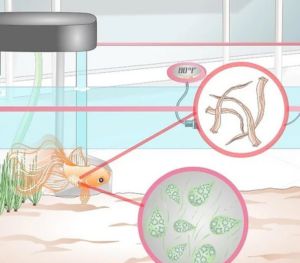
Treatment for dropsy
To successfully treat your fish for dropsy, you must first move the sick fish to a separate ‘hospital’ tank. This will keep the infection from spreading to other healthy fish. Then change the water of the original tank and keep watching the fish for any symptoms. Adding salt to the ‘hospital’ tank and feeding the sick fish fresh, high-quality foods can help them get better faster.
Dropsy is not an easy disease to cure, which makes its prevention better than cure. It’s important to avoid overcrowding the tank, and you must also maintain it well with water changes, filter cleaning and a balanced diet for the fish to minimize the chances of a dropsy outbreak in your aquarium.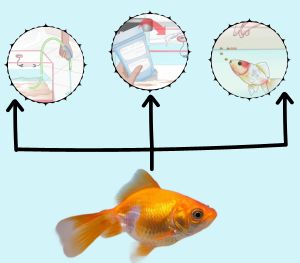
3. Fungus
Fungus in fish might look like cotton-like growth on the skin and gills. This disease is most common in freshwater aquariums, and if left untreated it can lead to secondary infections and cause other diseases like dropsy in fish. It can also often lead to death.
Fish fungus is caused by fungal spores. The disease first affects weaker fish such as stressed or injured fish. After that it can easily spread to healthier fish as well.
The common symptoms of fungus include furry growth along the gills and near the fish’s mouth. Infection near the mouth and gills can lead to difficulty in breathing or guppy breathing. Lumps and swelling, along with dark skin and clamped fins is also a sign that a fish might have fungus.
Poor aeration in tanks is one of the leading causes of fungus in fish. Inadequate airflow can lead to lack of oxygen and a rapid buildup of harmful gasses which further causes stress in fish and makes them an easy target for fungus.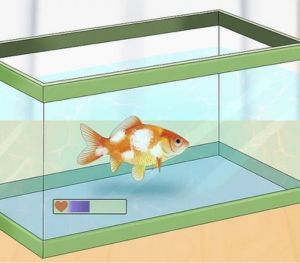
Treatment for Fish Fungus
Start the treatment for fish fungus as soon as you can. If you’re not sure how to go about it, it’s better to consult a professional. A vet or an aquatic pet expert will suggest two different treatment methods. First is medicated baths followed by oral medication which may include fungus cure (nitrofurazone), Nova-Zyme F, Pimafax, and Fluconazole (Diflucan).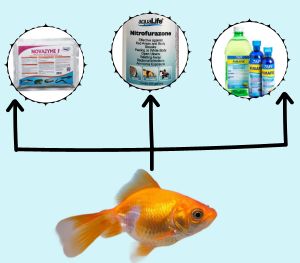
4. Popeye Disease
Scientifically known as exophthalmia, popeye disease is a condition that causes the eye of a fish to protrude from its socket because of fluid buildup behind or within the eye. In mild popeye cases, the eye suffers a moderate amount of swelling and stays clear. However, in more serious cases, the condition can damage the cornea and even rupture the eye causing it to fall out.
One of the common culprits that cause popeye disease in fish is physical injury. Fish are highly prone to bump into rocks, scrape their eyes or accidentally injure themselves in the tank.
Another cause could be an internal infection. If a fish is suffering from any other disease such as dropsy, or kidney failure, chances are it can also experience popeye.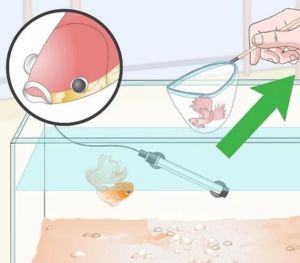
Treatment for Popeye Disease
Popeye fish treatment depends on the cause of the disease. If the cause is an injury, your best option is to let it heal on its own, as long as it doesn’t lead to a secondary infection. To aid the healing process, you can introduce aquarium salts that relieve swelling to help the fish recover fast.
You must also change the tank’s water and monitor its chemistry, along with removing aquarium grass decorations to prevent further injury.
If you suspect a bacterial infection, put the sick fish in a separate tank, where you can treat it with extra attention and antibiotics prescribed by a vet if needed.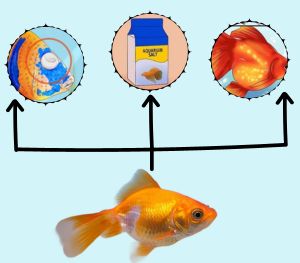
5. Swim Bladder
Is your fish suffering from a swollen or distended abdomen and is unable to swim upright? Chances are it has the swim bladder disease. Being unable to maintain buoyancy, sinking to the bottom or floating to the top are all symptoms of this condition. Swim bladder is caused by bacteria and the issue can be worsened by stress.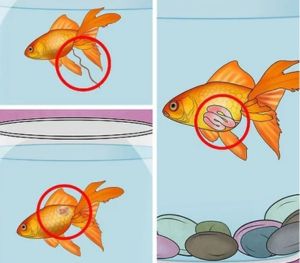
Treatment for Swim Bladder
Swim bladder disease treatment involves water treatment, changes in feeding routine, and administering antibiotics.
If an enlarged stomach is the cause of the disease, the first course of action is to not feed the fish for three days. You must also change the temperature of the tank to 78-80 degrees Fahrenheit during the treatment period. On the fourth day of the treatment, feed cooked and skinned peas to the fish.
If an infection is the cause of the disease, then administer professionally prescribed antibiotics to the fish.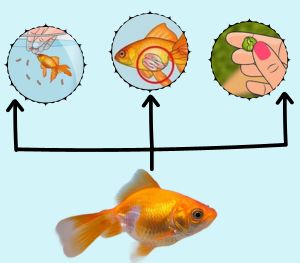
Conclusion
Proper care and treatment can help you restore your fish’s health no matter which diseases it’s suffering from. However, maintaining your tank’s water chemistry, cleaning the filter regularly, inspecting ammonia levels, giving a balanced diet fish food to your fish, and overall reducing any cause of stress for your fish is the best way to ensure a fresh and hearty environment in which they can grow and live a long and healthy life.



